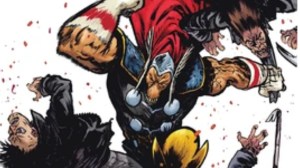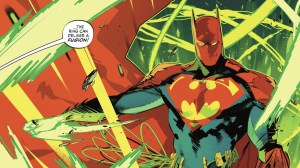It’s been four years since the last attempt at rebooting Witchblade came about, and while that series opted to try something new and introduce a fresh face to be its title character the 2024 version is returning to what fans know. This new series, hailing from writer Marguerite Bennet and artist Giuseppe Cafaro, brings back New York City detective Sara Pezzini as its lead and is a back-to-basics take on the material. However, the new Witchblade succeeds by not trying to emulate the 1990s version; it’s more interested in just looking ahead and trying to forge its own path, even if the franchise it’s building on houses layers of tedious world building.
Videos by ComicBook.com
Bennet begins with an unconventional hook, which is inviting for both new and longtime Witchblade readers. Sara Pezzini introduces herself and her world to us, while the Witchblade itself begins the search for its host (surprise, it’s her!) with some onlookers waiting to see who it will select. Pezzini is a cop that joined the force to find her father’s killers, while the sudden arrival of the Witchblade alters her path in ways that open up the narrative. The first issue brings the origin together in a a fast, modern fashion, though by the time you feel like the story is finding its footing, it’s over. That’s showbiz when it comes to debut issues these days, but the immense amount of set-up required to get Witchblade to its final pages is a lot for a single issue, though wanting more by the end isn’t a bad thing either.
The narrative structure of Witchblade #1’s writing is strengthened by the artistic contributions. Giuseppe Cafaro contributes line art to the series, setting the stage with a great amount of detail in its establishing shots and in smaller moments that really sell you on what this world is. Cafaro also manages to deliver great splash pages that do what those kinds of images should, capturing your attention with a bombastic moment and a defining point in the plot. They even manage to deploy a splash page requiring you turn the book ninety degrees to really appreciate it. Arif Prianto is the color artist on the series, setting the mood for every image by adding depth and making sure layers of colors flow together.
At least one marked improvement in the material over previous versions of Witchblade is that the sleaze factor has been toned down. Rather than single panels highlighting cleavage or moments where a woman just takes her pants off to reveal a thong, the story doesn’t even have a place for that (not yet at least, but it seems to be foundational for this version). For some this is perhaps the series losing its appeal, but an attempt to make a character like this work in a modern context without a stringent adherence to bawdiness feels like a win.
As good as Witchblade #1 looks and as well structured as it narrative is, the first issue isn’t without its stumbling blocks. It’s not that anyone unfamiliar with the series will be lost, rather nothing about its plot or character feels new. There’s a hint of rejuvenation from a macro view of the 1990s comic, but nothing in this first issue hints that some kind of radical take is on the horizon. By the end of the issue it’s still not entirely clear what the Witchblade can even do beyond vague magic fighting, but the thing working in its favor is that it at least looks very cool when doing that.
Published by Image Comics
On July 17, 2024
Written by Marguerite Bennet
Art by Giuseppe Cafaro
Colors by Arif Prianto
Letters by Troy Peteri
Cover by Marc Silvestri








